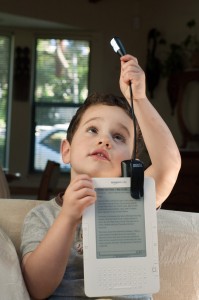
This summer, the School Library Journal stoked a debate long simmering in libraryland. Print books or ebooks: Which are better for helping children learn to read? Children’s librarians have strong opinions on the subject, as shown in essays published last week with battling headlines. In one corner of the ring: “The book is far superior to the ebook for literacy.” In the other: “Ebooks enhance the development of the whole child.” The essays came on the heels of two articles for SLJ written by Annie Murphy Paul, a recent New America fellow, that replay the controversies surrounding technology and give eight reasons why “print trumps digital” for reading.
Given the emotions stirred on both sides, it would be easy miss the point on which all writers agreed: Children’s librarians and school librarians can play — and should play — a huge role in modeling what it looks like to read with children and to help build discriminating tastes in quality books, e- or otherwise. We need twenty-first-century librarians to become what I and others have come to call “media mentors” for children and families.

We often get stuck on the pros and cons of e-books, especially when it comes to early literacy. Print books offer beautiful illustrations and enable children to touch and feel the weight of the paper as they turn the pages. Devoid of backlit screens, they are easier on the eyes. Plus, they come with no distractions. “It is the book, not the e-book, that invites and sustains parent-child interaction and the personal and intimate experience of sharing and talking through reading,” argues Kathy Kleckner of the Children’s Library of Minnesota. “Books need us.“
E-books have the benefit of interactive features, audio read-alouds and narrative questions built into their very pages, not to mention the ability to be stored en mass and clicked open anywhere at anytime. “Such tools can support and enhance adults’ role in supporting development of the whole child,” write Maryanne Martens and Dorothy Stoltz, librarians on the board of LittleELit, a website run by librarians who examine children’s apps and e-books. Just because a book is in print, doesn’t mean that it’s of higher quality. Print books, the authors argue, can just as easily feature “poor writing and mediocre illustrations that often function as promotional material for other branded merchandise.”
In an article for SLJ a few years ago, I reported on Julie Hume, a reading teacher in Missouri who was testing whether the read-along features in e-books would help one group of her students learn to read compared to another “control group” who didn’t have access. The article was simplistically titled “Are E-Books Any Good?,” but the aim was to help readers see the complexity of the issue. For struggling readers, Hume was amazed and pleased to find that the narration and animation in the e-books helped her students with reading fluency. And yet she was worried that they could also become a crutch. She wanted to help them read a book with text alone, whether digitized or printed, without “handholding.”
The answer to “e-books or print books?” clearly depends on which books, read in which way, for which children. It requires the intervention of thoughtful human beings — caring adults, discerning librarians, media mentors — who know the children they are trying to help and know the books with the features or qualities that match the children’s needs. It means equipping educators and librarians with the skills to be choosy and the ability to communicate those ideas to parents, as outlined in our March report, Envisioning a Digital Age Architecture for Early Education. Just as with print books, we should not assume that the simple presence of media will magically lead children to learn. Nor, as with print books, should we assume that children from disadvantaged backgrounds have easy access to ebooks, let alone access to adults who read to them or with them each day.
In a recent post on the Fred Rogers Center blog, LittleELit founder Cen Campbell reminds us that “evaluation and curation of children’s media have always been essential elements in the children’s librarian’s job description.” Martens and Stoltz, who already describe themselves as media mentors, wrote in their SLJ essay that they would steer children away from media “that focus on clever tech tricks at the expense of high quality text and art.” Among the questions they would ask: “Does the app or media experience reduce a child to a mere spectator?”
One of the most important tasks for these mentors will be to re-orient parents and caregivers who are accustomed to seeing digital media as a babysitter. Early research shows that e-books and other media can be used to help children learn words and recall information from stories if adults are using dialogic questioning and other read-aloud techniques with their children while they watch and read together. Studies on “joint media engagement,” as it is known in the field, are building on the “co-viewing” research of the early days of Sesame Street and showing potential for helping children learn.
But the bells and whistles of e-media can be powerful. As a parent myself, I am no stranger to the days when it’s easier to hand over the device, put children on autopilot, and never think to ask about what they are watching, playing, or reading. We need media mentors to encourage a different mindset and help all of us become more thoughtful about the media that children use, ebooks or otherwise.
For more: See my TEDx talk on apps, ebooks and media mentorship and Print Books vs. E-Books by Cynthia Chiong, Jinny Ree, Lori Takeuchi, and Ingrid Erickson.




